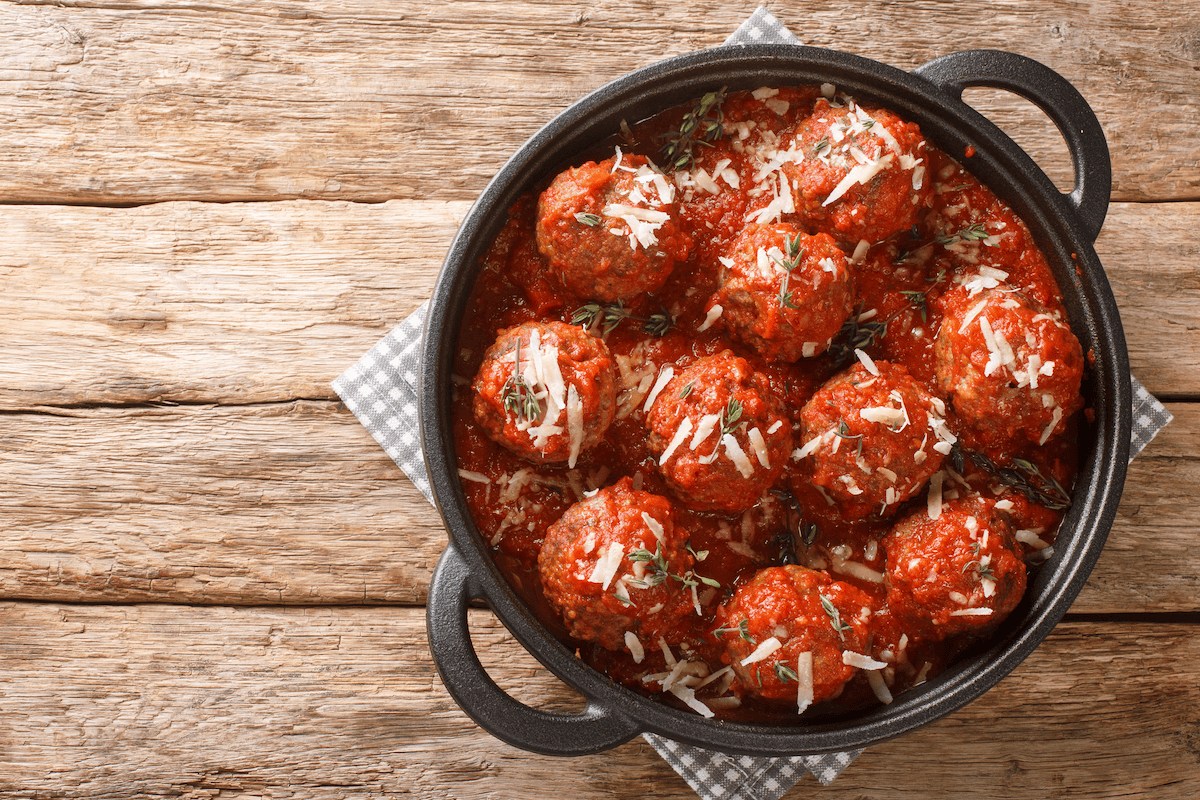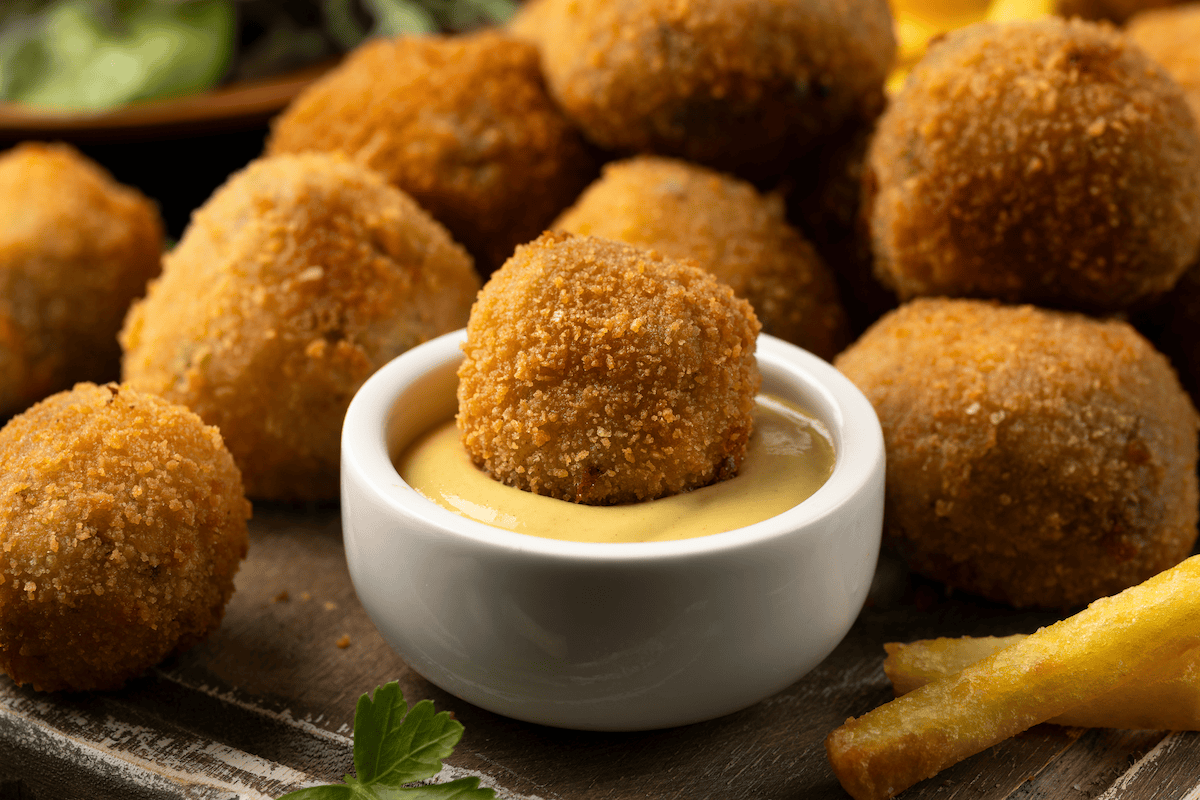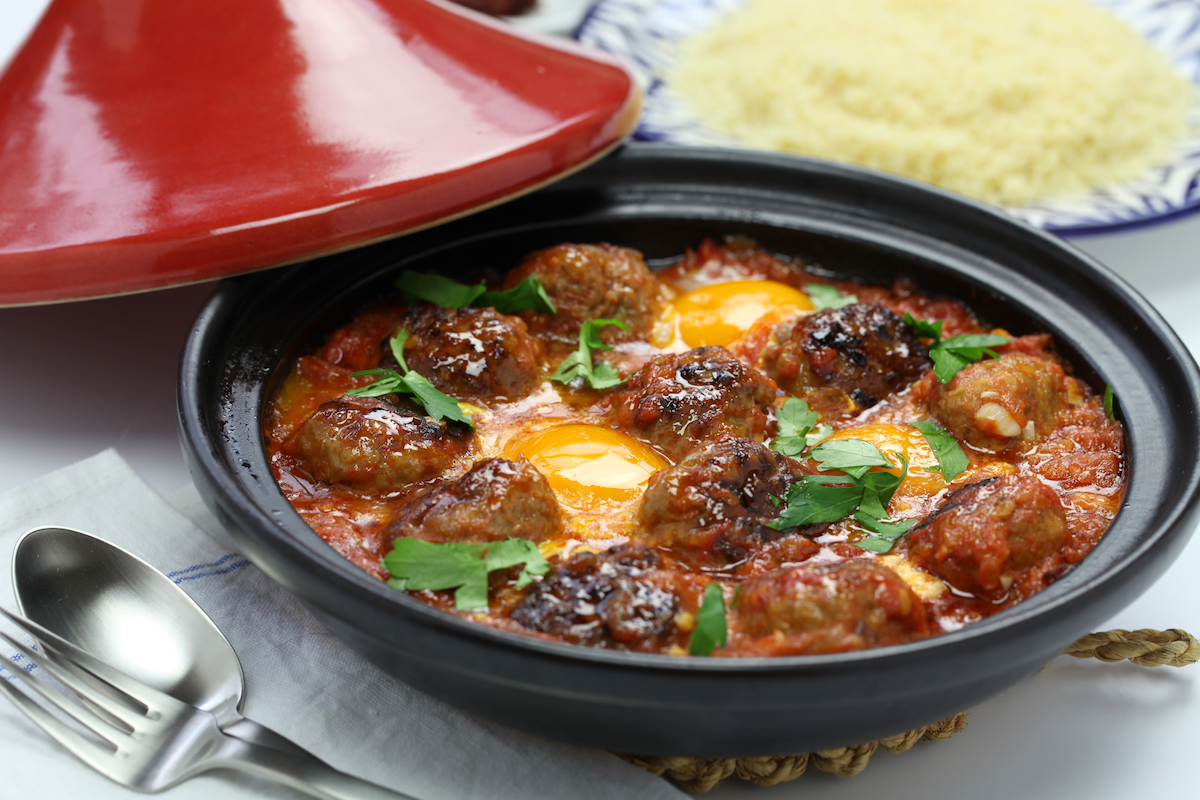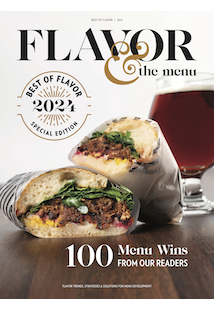
A Whole New “Ball” Game
7 classic meatball dishes from all points on the globe
A Whole New “Ball” Game
7 classic meatball dishes from all points on the globe
By Patricia Fitzgerald
July 30, 2024
By Patricia Fitzgerald
July 30, 2024
Meatballs check a long list of customer drivers. They’re generally familiar, but can be novel, too. They’re simple, but can showcase unexpected flavor depth. They can be bold or subtle. They’re both nostalgic and contemporary. Deeply rooted in cuisines from all corners, they convey a sense of place and culture.
“Meatballs are trending in global formats, in sandwiches, with noodles or even on skewers, and embracing local flavors for their seasonings, stuffings, coatings and sauces,” declared Robert Danhi, executive chef and CEO of the food and beverage consultancy Chef Danhi & Co., predicting on-the-horizon breakouts as part of Flavor & the Menu‘s 2024 Top 10 Trends.
The chef has done a deep dive into global meatballs, exploring their evolution of form, flavor and function. “Everywhere around the world has some kind of meatball,” he says. “The meatball is a platform that welcomes pretty much any type of animal meat that is ground or hand-chopped. It can transform tough cuts into tender morsels, and also invites a myriad of flavor profiles.”
Layer in a variety of preparation techniques (simmered, steamed, grilled, deep-fried, baked, poached) as well as menu applications that see them bathed in a sauce, soup or pho. Tuck skewered meatballs into handhelds like pita pockets or hoagie rolls, or serve them dry with a dipping sauce—everything from marinara to mustard and Sriracha to tare. The flexibility and versatility of meatballs, Danhi notes, makes them ideal for virtually any type of cuisine. And if labor is an issue, operators often can have them made to spec ahead of time. “They typically freeze, ship and store well,” he reports.
Flavor-forward meatballs are built from the careful calibration of certain components: the animal protein, binders (egg, breadcrumbs, rice), produce (aromatics, vegetables), seasonings (spices), “moisture magnets” (sauces, starches) and tenderizers (baking soda). Additional flavor can come from an internal (aka “stuffed”) garnish or one applied after cooking (glazes, drizzles, sprinkles, dips).
“But what’s really important with meatballs is texture, which comes from a cohesive structure,” says Danhi. “The window of opportunity is finding the sweet spot between grainy and bouncy.”
Seven Global Favorites

Unlike the American take on Italian meatballs, polpette are bite-sized nuggets typically served alone rather than atop pasta.
If mastering the fundamental elements of meatballs is table stakes, menu developers won’t risk much when gambling on the potential success of different flavor profiles, especially as diners of all demographics welcome global twists on everything from appetizers to entrées. With dozens of regional variations to choose among, here are seven types of meatballs worth betting on.
1
Polpette
This traditional Italian recipe will be one that resonates with Americans who have enjoyed beef meatballs in a hearty tomato sauce (frequently topping a plate of spaghetti) for generations. Classic polpette, however, tend to feature bite-sized nuggets, rather than larger spheres that account for multiple forkfuls, and the meatballs aren’t served over pasta.
The Spicy Meatball Skillet from sports lodge concept Twin Peaks would seem a good translation of this dish. Alex Sadowsky, director of culinary, beverage and menu innovation, had been patiently tracking the popularity of meatballs, watching and waiting for them to trend on bar bites menus. Late in 2020, deeming the timing to be right, the brand introduced the Spicy Meatball Skillet, which earned a permanent place on the menu months later. Leaning into a mixture of beef, mozzarella, Parmesan and parsley, plus rich, thick tomato sauce, the starter is served with toasted garlic bread.
Polpette would be a natural fit for Italian concepts seeking to expand their menus a bit, with elevation opportunities found in exploring different cheeses and mixing the beef with pork or veal. These Italian meatballs also lend themselves to personalization trends. The now-closed Polpetti Meatball Bar quick serve in Chicago specialized in customizable creations, allowing diners to build their meal, selecting the meatball flavor (mixing and matching beef, chicken, spicy pork sausage and vegetarian as desired), the format (bowl, panini, pasta or sub sandwich), sauce (red and white choices) and a range of vegetable, cheese and seasoning options.
2
Bitterballen

These fried, croquette-style meatballs easily lend themselves to dunking or double-dipping with a sauce and crunchy topping.
Given the American passion for fried foods, it’s somewhat surprising that bitterballen have yet to attract more attention on menus here. “They’re deep fried—it’s as simple as that,” says Danhi of this Dutch croquette-style dish.
Unlike many other forms of meatballs that rely on ground meat, bitterballen (a single meatball is a bitterbal) start as a meat ragout. Minced beef or veal is combined with seasonings, beef stock and roux, then stewed long and slow. After cooking, the mixture is refrigerated until firm and formed into balls, which are subsequently breaded and fried. Bitterballen is typically served with mustard or other dipping sauces. Preparation of the meat takes time, but the dish itself can be quick to execute on order as a shareable appetizer.
While the dish has plenty of menu potential in its traditional format, chefs can explore inventive riffs. “Create a meatball formed of the meat ragout, but add sauerkraut and coat with rye breadcrumbs before frying. Serve with a dip alone or add a double crunch with croutons of rye and cheese,” Danhi suggests.
3
Albondigas
These savory meatballs came to Mexico during Spain’s colonial rule but eventually gained their own identity in both ingredient components and menu applications. A classic Mexican albondigas meatball includes ground meat, rice, egg, cilantro paste and breadcrumbs, which are shaped into balls and then quick-fried or baked. Its most iconic application is Mexican meatball soup, swimming alongside vegetables in a simple broth. Modern chefs can build different soup varieties around the classic flavor profile of the meatball, while tapping other ingredients in the Mexican pantry.
But albondigas needn’t be consigned to soups. Chefs can leverage their small size and distinct flavor by tucking them into handhelds, sprinkling them atop flatbreads or even stuffing them into bell peppers. At Oyamel, José Andrés’ authentic and inventive Mexican concept in Washington, D.C., the Albondigas Enchipotladas con Queso Doble Crema sees the meatballs served in a chipotle sauce with queso fresco and cilantro.
4
Tsukune

Catching the coattails of yakitori’s budding popularity, Japanese meatballs are poised to curry favor with American diners.
With Japanese yakitori—a street food favorite—already gaining popularity in the U.S., tsukune shouldn’t be too far behind, predicts Danhi. Instead of strips of chicken meat, tsukune features ground chicken (ideally, a mix of breast and thigh meat) and grated onion, but once formed into spheres or oblong shapes, the meatballs are similarly skewered and chargrilled with a sweet-savory tare or soy sauce.
“The skewer gives customers more options for eating on the go, dipping in a sauce or wrapping in bread with other ingredients,” Danhi says. He advocates again for the double-dip crunch. “Dip the meatballs in a sauce and then again in a crunchy topping. I’m always surprised that satays have not run with this idea yet.” Japanese mayonnaise makes for a good wet dip, adding toasted sesame seeds for texture and allowing shichimi togarashi (Japanese seven-spice) to provide a distinctive kick.
In Honolulu, Tsukuneya Robata Grill serves tsukune in an oblong shape, offering an array of sauce and spice options for nearly 20 different flavor profiles. Patrons can choose the usuals, such as teriyaki, lightly salted, mustard and peppercorn, or try more robust alternatives like spicy miso, wasabi, yuzu daikon, goma or misonnaise.
5
Xíu Mái
Steaming is the secret behind these super-moist Vietnamese meatballs, made with ground pork, jicama and aromatics, and smothered in a sweet and tangy tomato sauce. While xíu mái can be easily plated, street food stalls often serve them stuffed into a baguette along with lettuce or pickled vegetables. These meatballs are also considered a popular filling for banh mi sandwiches, which pretty much defines the opportunity, Danhi says. Not only is the banh mi finding footing as an exciting flavor system in a range of applications, but the “super-popular” sandwich itself is a winner. “I mean, come on: The meatball sandwich is as classic American fare as pizza,” he insists.
Like other global meatballs, xíu mái works in a wide variety of presentations. “Traditionally prepared, they are a bit soft for skewers, but if you make them a bit firmer, you could steam or grill them on the skewer and then serve with a tomato dipping sauce,” says Danhi. “This flavor has so many possibilities.”
6
Kofta

Given its regional spread, traditional kofta can feature any number of meat combinations and cooking techniques.
Several regions—from western Africa through the Middle East and across to India—can lay claim to some variation of kofta. But this spectrum can be a boon to chefs seeking their own way into this dish without the burden of high expectations of what kofta “should” be. “It’s already established in different flavors and textures,” says Danhi. The sky’s the limit for contemporary translations that align with the rest of the menu. Chefs can grill, bake, steam, fry or poach meatballs; they can simmer the kofta in a stew, stuff a flatbread or skewer them on a kebab.
Depending on the region, kofta meats range from beef and lamb to pork and chicken, but one overlapping tradition is to use bulgur or breadcrumbs to stretch the meat portion, making the dish less expensive, Danhi notes. In general, the choice of seasonings and other filling ingredients will signal the origin of a particular kofta dish. For example, chiftele, a Romanian version, uses ground pork mixed with mashed potatoes, while tomatokeftedes is a Greek vegetarian variation with the balls formed of crushed tomatoes; both of these “meatballs” are fried.
7
Swedish Meatballs
For operators seeking to ride the “newstalgia” wave, Swedish meatballs might be an effective platform. A dinner party favorite 50 years ago, köttbullar later became an essential aspect of furniture shopping at IKEA. Today, their sweet-ish alternative to spicy, tangy meatballs is newly appealing.
Swedish meatballs are a 50/50 blend of ground pork and beef, mixed with milk-soaked breadcrumbs, onion and egg and often seasoned with warm spices like nutmeg and allspice, before being rolled into small balls and oven-baked or pan-fried in butter. The meatballs are added to a gravy made from beef broth and heavy cream. Some recipes incorporate lingonberry jam into the gravy, but most serve it as a dipping side for the meatballs.
“Now could be a good time to reinvent this dish,” says Danhi, “perhaps by adding more spice and some crispy toppings, along with the conventional gravy made with lingonberry jam to stay sweet and poppable.” Whether transformed or traditional, Swedish meatballs could be a good option for operators seeking to tap the Scandi café culture identified as one of Flavor & The Menu’s 2024 Top 10 Trends.
Start the Ball Rolling
As a culinary touchstone of many cultures around the world, meatballs boast a rich flavor history that continues today. They can be customized into a range of sizes, shapes and compositions, inviting menu developers to build their own one-of-a-kind variations. In terms of market translation, it helps that so many diners are already familiar with—and fans of—the dish. Keep your eye on the “ball” for opportunities to set your menu apart.
About the Author
![]() Patricia Fitzgerald serves different roles on the Flavor & The Menu team, including writing custom content, Kitchen Collaborative chef spotlights and digital editorial content, as well as acting as a contributing editor for the print magazine. As owner of PFitzCommunications, she specializes in various areas of foodservice and hospitality, while also maintaining clients in other industries and professions. She can be reached at [email protected].
Patricia Fitzgerald serves different roles on the Flavor & The Menu team, including writing custom content, Kitchen Collaborative chef spotlights and digital editorial content, as well as acting as a contributing editor for the print magazine. As owner of PFitzCommunications, she specializes in various areas of foodservice and hospitality, while also maintaining clients in other industries and professions. She can be reached at [email protected].







